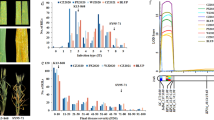Summary
Soybean (S, Glycine max (L.) Merr.) lines with relatively few cysts of soybean cyst nematode (CN, Heterodera glycines Ichinohe) populations are usually called CN-resistant. The phenotype of number of cysts per plant is of the CN-S (Cyst Nematode-Soybean) association and determined by the interactions of genes for avirulence-resistance. The acronym “alins” was proposed for these alleles for incompatibility, with “xalin” representing the interaction X of one microsymbiont malin with its host h-alin. These alins are dominant in the gene-for-gene model but may be mostly recessive with CN-S. Definitive genetic studies have been hindered by the heterogeneity of sexually reproducing CN populations and lack of the appropriate genetic models. Loegering's abstract interorganismal genetic model was modified so that one model represented all four possible interactions of dominant-recessive alins for an incompatible phenotype. This involved redefining the Boolean algebra symbol 1 to represent both the alins AND their frequencies. The model was used to derive the relationship: {ie893-01} where the expectation E of cysts (of any CN-S combination, as proportion of number of cysts on a check cultivar) is proportional to the product Π of CN genotypic frequencies expressed as functions of m-alin frequencies. Each m-alin is at a different locus, i.e., {ie893-02}. The number of terms multiplied for each CN-S is equal to the number of alins in the S line (or F2 plant). There are too many unknowns in the equation to solve for any of them. The relationship does explain the continuous distributions of phenotypes that were nearly always observed. Basic genetic principles were used to concurrently derive the models and to obtain discontinuous distributions of numbers of cyst phenotypes in segregating generations due to one recessive alin in a CN-“susceptible” soybean line.
Similar content being viewed by others
References
Browder LE (1985) Parasite:host: environment specificity in the cereal rusts. Annu Rev Phytopathol 23:201–222
Ellingboe AH (1976) Genetics of host-parasite interactions. In: Heitefuss R, Williams PH (eds) Physiological plant pathology. (Encyclopedia of plant physiology, N.S.4). Springer, Berlin Heidelberg New York, pp 761–778
Ellingboe AH (1982) Host resistance and host-parasite interactions: a perspective. In: Mount MS, Lacy GH (eds) Phytopathogenic prokaryotes, vol 2. Academic Press, New York, pp 103–117
Ellingboe AH (1983) Genetical aspects of interaction between plant hosts and their soilborne pathogens. Phytopathology 73:941–944
Evans DM, Fox JA (1977) The sex ratio of Heterodera glycines at low population densities. J Nematol 9:207–210
Falconer DS (1981) Introduction to quantitative genetics, 2nd edn. Ronald Press, New York
Flor HH (1971) Current status of the gene-for-gene concept. Annu Rev Phytopathol 9:275–296
Hancock JA, Hancock FG, Caviness CE, Riggs RD (1987) Genetics of resistance in soybean to “race X” of soybean cyst nematode. Crop Sci 27:704–707
Hartwig EE (1981) Breeding productive soybean cultivars resistant to the soybean cyst nematode for the Southern United States. Plant Dis 65:303–305
Hartwig EE, Lehman SG (1951) Inheritance of resistance to the bacterial pustule disease in soybeans. Agron J 43:226–229
Keeling BL (1982) Four new physiologic races of Phytophthora megasperma f. sp. glycinea. Plant Dis 66:334–335
Koliapanos CN, Triantaphyllou AC (1972) Effect of infection density on sex ratio of Heterodera glycines. Nematologica 18:131–137
Layton AC, Athow KL, La Violette FA (1984) Inheritance of resistance to Phytophthora megasperma f. sp. glycinea in a soybean plant introduction. Plant Dis 68:1080–1083
Lehman PS, Dunn FA (1987) Distribution of Florida populations of the soybean cyst nematode with previously described genetic variation. Plant Dis 71:68–70
Loegering WQ (1978) Current concepts in interorganismal genetics. Annu Rev Phytopathol 16:309–320
Loegering WQ (1984) Genetics of the pathogen — host association. In: Bushnell WR, Roelfs AP (eds) The cereal rusts. Academic Press, New York London, pp 165–192
Long SR, Meade HM, Brown SE, Ausubel FM (1982) Transposon-induced mutants of Rhizobium meliloti. In: Panopoulos NJ (ed) Genetic engineering in the plant sciences. Praeger, New York
Luedders VD (1983) Genetics of the cyst nematode-soybean symbiosis. Phytopathology 73:944–948
Luedders VD (1985) Selection and inbreeding of Heterodera glycines on Glycine max. J Nematol 17:400–404
Luedders VD (1987) A recessive gene for a zero cyst phenotype in soybean. Crop Sci 27:604–606
Peterson MA, Barnes DK (1981) Inheritance of ineffective nodulation and non-nodulation traits in alfalfa. Crop Sci 21:611–616
Rao AP, Anand SC (1986) Screening for cytoplasmic/maternal effects in resistance to soybean cysts nematodes. Soybean Genet Newslett 13:132–133
Rennie BD, Beversdorf WD (1987) On the response of the Rpslb allele to race 17 of Phytophthora megasperma f. sp. glycinea. Soybean Gene Newslett 14:82–84
Triantaphyllou AC (1975) Genetic structure of races of Heterodera glycines and inheritance of ability to reproduce on resistant soybeans. J Nematol 3:356–364
Triantaphyllou AC (1987) Genetics of nematode parasitism on plants. In: Veech JA, Dickson DW (eds) Vistas on Nematology. Painter, DeLeon Springs/Fl, pp 354–363
Wheeler H (1975) Plant pathogenesis. (Advanced series agricultural Sc. 2) Springer, Berlin Heidelberg New York
Wiberg A (1973) Mutants of barley with induced disease resistance to powdery mildew. Hereditas 75:83–100
Williams LJ, Lynch DL (1953) Inheritance of a non-nodulating character in soybean. Agron J 64:28–29
Young LD (1984) Changes in the reproduction of Heterodera glycines on different lines of Glycine max. J Nematol 16:304–309
Author information
Authors and Affiliations
Additional information
Communicated by A. L. Kahler
Contribution from the Missouri Agricultural Experiment Station, Journal Series No. 9739
Rights and permissions
About this article
Cite this article
Luedders, V.D. Relationship of cyst nematode gene frequencies to soybean resistance. Theoret. Appl. Genetics 77, 893–898 (1989). https://doi.org/10.1007/BF00268345
Received:
Accepted:
Issue Date:
DOI: https://doi.org/10.1007/BF00268345




